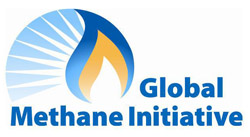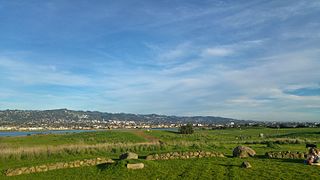Related Research Articles

Biogas is a gaseous renewable energy source produced from raw materials such as agricultural waste, manure, municipal waste, plant material, sewage, green waste, wastewater, and food waste. Biogas is produced by anaerobic digestion with anaerobic organisms or methanogens inside an anaerobic digester, biodigester or a bioreactor. The gas composition is primarily methane and carbon dioxide and may have small amounts of hydrogen sulfide, moisture and siloxanes. The gases methane and hydrogen can be combusted or oxidized with oxygen. This energy release allows biogas to be used as a fuel; it can be used in fuel cells and for heating purpose, such as in cooking. It can also be used in a gas engine to convert the energy in the gas into electricity and heat.

Colma is a small incorporated town in San Mateo County, California, United States, on the San Francisco Peninsula in the San Francisco Bay Area. The population was 1,507 at the 2020 census. The town was founded as a necropolis in 1924.

A landfill site, also known as a tip, dump, rubbish dump, garbage dump, trash dump, or dumping ground, is a site for the disposal of waste materials. Landfill is the oldest and most common form of waste disposal, although the systematic burial of the waste with daily, intermediate and final covers only began in the 1940s. In the past, refuse was simply left in piles or thrown into pits; in archeology this is known as a midden.

A leachate is any liquid that, in the course of passing through matter, extracts soluble or suspended solids, or any other component of the material through which it has passed.

Landfill gas is a mix of different gases created by the action of microorganisms within a landfill as they decompose organic waste, including for example, food waste and paper waste. Landfill gas is approximately forty to sixty percent methane, with the remainder being mostly carbon dioxide. Trace amounts of other volatile organic compounds (VOCs) comprise the remainder (<1%). These trace gases include a large array of species, mainly simple hydrocarbons.

Municipal solid waste (MSW), commonly known as trash or garbage in the United States and rubbish in Britain, is a waste type consisting of everyday items that are discarded by the public. "Garbage" can also refer specifically to food waste, as in a garbage disposal; the two are sometimes collected separately. In the European Union, the semantic definition is 'mixed municipal waste,' given waste code 20 03 01 in the European Waste Catalog. Although the waste may originate from a number of sources that has nothing to do with a municipality, the traditional role of municipalities in collecting and managing these kinds of waste have produced the particular etymology 'municipal.'

The Global Methane Initiative (GMI) is a voluntary, international partnership that brings together national governments, private sector entities, development banks, NGOs and other interested stakeholders in a collaborative effort to reduce methane gas emissions and advance methane recovery and use as a clean energy source. National governments are encouraged to join GMI as Partner Countries, while other non-State organizations may join GMI's extensive Project Network. As a public-private initiative, GMI creates an international platform to build capacity, development methane abatement strategies, engage in technology transfer, and remove political and economic barriers to project development for emissions reduction.

Waste-to-energy (WtE) or energy-from-waste (EfW) is the process of generating energy in the form of electricity and/or heat from the primary treatment of waste, or the processing of waste into a fuel source. WtE is a form of energy recovery. Most WtE processes generate electricity and/or heat directly through combustion, or produce a combustible fuel commodity, such as methane, methanol, ethanol or synthetic fuels, often derived from the product syngas.
A mechanical biological treatment (MBT) system is a type of waste processing facility that combines a sorting facility with a form of biological treatment such as composting or anaerobic digestion. MBT plants are designed to process mixed household waste as well as commercial and industrial wastes.
Landfills are the primary method of waste disposal in many parts of the world, including United States and Canada. Bioreactor landfills are expected to reduce the amount of and costs associated with management of leachate, to increase the rate of production of methane for commercial purposes and reduce the amount of land required for land-fills. Bioreactor landfills are monitored and manipulate oxygen and moisture levels to increase the rate of decomposition by microbial activity.
Landfill gas monitoring is the process by which gases that are collected or released from landfills are electronically monitored. Landfill gas may be measured as it escapes the landfill or may be measured as it is collected and redirected to a power plant or flare.

César Chávez Park is a 90 acres (36 ha) city park of Berkeley, California named after César Chávez. It can be found on the peninsula on the north side of the Berkeley Marina in the San Francisco Bay and is adjacent to Eastshore State Park.

Fresno Municipal Sanitary Landfill in Fresno, California, was the first modern landfill in the U.S., pioneering the use of trenching, compacting, and daily burial to combat rodent and debris problems. It became a model for other landfills around the country, and one of the longest-lived. The landfill was operated by the City of Fresno from 1937 until 1987, when it was closed. At that time, the landfill had reached the size of 145 acres (0.59 km2).
In the densely populated Hong Kong, waste is a complex issue. The territory generates around 6.4 million tons of waste each year but is able to collect and process only a minimal portion of recyclable waste. By 2019, its existing landfills are expected to be full. The government has introduced waste management schemes and is working to educate the public on the subject. On the commercial side, producers are taking up measures to reduce waste.

Municipal solid waste (MSW) – more commonly known as trash or garbage – consists of everyday items people use and then throw away, such as product packaging, grass clippings, furniture, clothing, bottles, food scraps and papers. In 2018, Americans generated about 265.3 million tonnes of waste. In the United States, landfills are regulated by the Environmental Protection Agency (EPA) and the states' environmental agencies. Municipal solid waste landfills (MSWLF) are required to be designed to protect the environment from contaminants that may be present in the solid waste stream.

Landfill gas utilization is a process of gathering, processing, and treating the methane or another gas emitted from decomposing garbage to produce electricity, heat, fuels, and various chemical compounds. After fossil fuel and agriculture, landfill gas is the third largest human generated source of methane. Compared to CO2, methane is 25 times more potent as a greenhouse gas. It is important not only to control its emission but, where conditions allow, use it to generate energy, thus offsetting the contribution of two major sources of greenhouse gases towards climate change. The number of landfill gas projects, which convert the gas into power, went from 399 in 2005 to 519 in 2009 in the United States, according to the US Environmental Protection Agency. These projects are popular because they control energy costs and reduce greenhouse gas emissions. These projects collect the methane gas and treat it, so it can be used for electricity or upgraded to pipeline-grade gas. These projects power homes, buildings, and vehicles.
Plasma gasification is in commercial use as a waste-to-energy system that converts municipal solid waste, tires, hazardous waste, and sewage sludge into synthesis gas (syngas) containing hydrogen and carbon monoxide that can be used to generate power. Municipal-scale waste disposal plasma arc facilities have been in operation in Japan and China since 2002. No commercial implementations in Europe and North America have succeeded so far. The technology is characterized by the potential of very high level of destruction of the incoming waste, but low or negative net energy production and high operational costs.
The Newby Island Landfill (NISL) is one of the largest active landfills on the shores of the San Francisco Bay. It is located in Santa Clara County, California in the United States. The site is located within the city limits of San Jose, California at the western terminus of Dixon Landing Road. The address is 1601 Dixon Landing Road, Milpitas. Although the address and public street access to the site are both in the City of Milpitas, the landfill property is entirely within the City of San Jose. Newby Island Landfill has a length of 5.07 km (3.15 mi). It is located West of the City of Milpitas near Dixon Landing Road and Interstate 880. It is the terminus for waste for all of San Jose (62%), Santa Clara (14%), Milpitas (10%), Cupertino (5%), Los Altos (2%) and other cities (7%). The 342-acre pile is currently permitted to operate until 2041 and may extend up to 245 feet. The landfill is an island surrounded by a levee which keeps its runoff from directly entering the bay, and the water that drains from it is treated in the landfill's own treatment plant. Electricity for the landfill is generated by burning the methane collected from the decomposition of the waste. Dried sewage sludge from the nearby San José–Santa Clara Regional Wastewater Facility is the material used as cover, mixed in with the trash, blending San Jose's waste streams. It is operated by Republic Services (Republic), which, along with Waste Management Incorporated, transports and disposes of most of the household trash in the United States.

The Scholl Canyon Landfill is a municipal solid waste disposal facility and landfill located in the central San Rafael Hills, within eastern Glendale in Los Angeles County, southern California. The 314 acres (127 ha) of land is located at 3001 Scholl Canyon Road, north of the Ventura Freeway, east of the Glendale Freeway, north of Eagle Rock, and west of the Arroyo Seco. It is owned by the City of Glendale. The landfill opened in 1961.
References
This article includes a list of references, related reading, or external links, but its sources remain unclear because it lacks inline citations .(August 2009) |
- Bay Area Rapid Transit District, Virtual art tour on the BART system, 2006
- Earth Metrics Inc., Marc. Papineau, Ballard. George, Jill Buxton et al., Environmental Impact Report for the Metro Center, Colma, California, Report #10062, published by city of Colma Planning Department and the California State Clearinghouse, December, 1989
- Hart, E.W., Fault-Rupture Hazard Zones in California: California Division of Mines and Geology, Special Publication #42 (1985)
- SCS Engineers, Solid Waste Association of North America, 2002